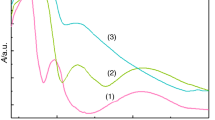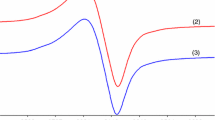Abstract
A series of complexes [M2L2Cl2(OH2) n ]·mH2O (M: Co, n = 0, m = 1; M: Ni, n = 2, m = 0; M: Cu, n = 0, m = 0; M: Zn, n = 0, m = 1; HL·H2O: 2-[(E)-1H-1,2,4-triazol-3-ylimino)methyl]phenol) were synthesised and characterised. The features of complexes have been assigned from microanalytical, thermal, IR, UV–Vis-NIR, EPR spectroscopy as well as magnetic data at room temperature. The electrochemical behaviour of the complexes was also investigated by cyclic voltammetry. The simultaneous TG/DTA experiments of these in flowing air atmosphere evidenced the occurrence of water or chloride as well as oxidative degradation of the Schiff base. The final product of decomposition was the most stable metal oxide as powder X-ray diffraction indicates. The complexes exhibited an improved antibacterial activity in comparison with the ligand towards both planktonic as well as biofilm embedded cells. The Cu(II) and Zn(II) complexes exhibited an inhibitory effect on the tumor cell lines growth, as revealed by the increased G2 phase and percentage of apoptotic/necrotic cells.






Similar content being viewed by others
References
Costerton JW, Stewart PS, Greenberg EP. Bacterial biofilms: a common cause of persistent infections. Science. 1999;284:1318–22.
Lazar V. Quorum sensing in biofilms—how to destroy the bacterial citadels or their cohesion/power? Anaerobe. 2011;17:280–5.
Glinel K, Thebault P, Humblot V, Pradier CM, Jouenne T. Antibacterial surfaces developed from bio-inspired approaches. Acta Biomater. 2012;8:1670–84.
Tournu H, Van Dijck P. Candida Biofilms and the host: models and new concepts for eradication. Intern J Microbiol. 2012;2012:ID. 845352 doi:10.1155/2012/845352.
Potts KT. The Chemistry of 1,2,4-Triazoles. Chem Rev. 1961;61:87–127.
Agalave SG, Maujan SR, Pore VS. Click chemistry: 1,2,3-triazoles as pharmacophores. Chem Asian J. 2011;6:2696–718.
Whiting M, Muldoon J, Lin Y-C, Silverman SM, Lindstrom W, Olson AJ, Kolb HC, Finn MG, Sharpless KB, Elder JH, Fokin VV. Inhibitors of HIV-1 protease by using in situ click chemistry. Angew Chem Int Ed. 2006;45:1435–9.
Zhou C-H, Wang Y. Recent researches in triazole compounds as medicinal drugs. Curr Med Chem. 2012;19:239–80.
Sun N, Xie Y, Sheng C, Cao Y, Zhang W, Chen H, Fan G. In vivo pharmacokinetics and in vitro antifungal activity of iodiconazole, a new triazole, determined by microdialysis sampling. Int J Antimicrob Agents. 2013;41:229–35.
Kleemann A, Engel J. Pharmaceutical Substances. Stuttgart: Thieme Verlag; 1999.
Kharb R, Sharma PC, Yar MS. Pharmacological significance of triazole scaffold. J Enz Inhib Med Chem. 2011;26:1–21.
Sahoo S, Veliyath SK, Mahendra Kumar CB. Review on substituted 1,2,4-triazoles as potent antifungal and antibacterial agents. Int J Res Pharm Sci. 2012;3:326–33.
Wahi AK, Singh AK, Singh A. Design and synthesis of novel Schiff’s bases having N-(4H-1,2,4-triazole-4-yl)benzamido moiety as antimicrobial and anti-inflammatory agents. Pharm Chem. 2011;3:146–54.
Chandramouli C, Shivanand MR, Nayanbhai TB, Bheemachari B, Udupi RH. Synthesis and biological screening of certain new triazole schiff bases and their derivatives bearing substituted benzothiazole moiety. J Chem Pharm Res. 2012;4:1151–9.
Sumangala V, Poojary B, Chidananda N, Arulmoli T, Shenoy S. Synthesis and biological evaluation of some Schiff bases of 4-amino-5-(4-methylsulfonyl)benzyl-2,4-dihydro-3H-[1, 2, 4]-triazole-3-thione. Med Chem Res. 2013;22:2921–8.
Murthy YLN, Govindh B, Diwakar BS, Nagalakshmi K, Rao KVR. Synthesis and bioevaluation of Schiff and Mannich bases of isatin derivatives with 4-amino-5-benzyl-2,4-dihydro-3H-1,2,4-triazole-3-thione. Med Chem Res. 2012;21:3104–10.
Zheng Y, Xue W, Guo Q, Lu P, Wang Z, Yuan K. Synthesis and antitumor activity of 5,6-2H-[1,2,4]-triazolo[3,4-b][1,3,4]thiadiazine derivatives. Chin J Org Chem. 2011;31:912–6.
Serbest K, Özen A, Ünver Y, Er M, Değirmencioğlu I, Sancak K. Spectroscopic and theoretical study of 1,2,4-triazole-3-one based salicylaldimine complexes and evaluation of superoxide-scavenging properties. J Mol Struct. 2009;922:1–10.
Ma L, Lu L, Zhu M, Wang Q, Li Y, Xing S, Fu X, Gao Z, Dong Y. Mononuclear copper(II) complexes with 3,5-substituted-4-salicylidene-amino-3,5-dimethyl-1,2,4-triazole: Synthesis, structure and potent inhibition of protein tyrosine phosphatases. Dalton Trans. 2011;40:6532–40.
Kulkarni NV, Budagumpi S, Kurdekar GS, Revankar VR, Didagi S. Anticonvulsant activity and toxicity evaluation of Cu(II) and Zn(II) metal complexes derived from triazole-quinoline ligands. Chem Pharm Bull. 2010;58:1569–75.
Bagihalli GB, Avaji PG, Patil SA, Badami PS. Synthesis, spectral characterization, in vitro antibacterial, antifungal and cytotoxic activities of Co(II), Ni(II) and Cu(II) complexes with 1,2,4-triazole Schiff bases. Eur J Med Chem. 2008;43:2639–49.
Reddy V, Patil N, Reddy T, Angadi SD. Synthesis, characterization and biological activities of Cu(II), Co(II), Ni(II), Mn(II) and Fe(III) complexes with Schiff base derived from 3-(4-chlorophenoxymethyl)-4-amino-5-mercapto-1,2,4-triazole. Eur J Chem. 2008;5:529–38.
Zabin SA. Synthesis and antimicrobial studies of Cu(II), Ni(II) and Zn(II) Schiff base complexes derived from substituted 1,2,4-triazoles and heteroaromatic aldehydes. Asian J Chem. 2011;23:4067–71.
Chohan ZH, Hanif M. Synthesis and characterization of biologically active new Schiff bases containing 3-functionalized 1,2,4-triazoles and their zinc(II) complexes: crystal structure of 4-bromo-2-[(E)-(1H-1,2,4-triazol-3-ylimino)-methyl]phenol. Appl Organomet Chem. 2011;25:753–60.
Creaven BS, Devereux M, Foltyn A, McClean S, Rosair G, Thangella VR, Walsh M. Quinolin-2(1H)-one-triazole derived Schiff bases and their Cu(II) and Zn(II) complexes: possible new therapeutic agents. Polyhedron. 2010;29:813–22.
Altalbawy FMA, Mohamed GG, Sayed MAEE, Mohamed MIA. Synthesis, characterization, and biological activity of some transition metal complexes with Schiff base ligands derived from 4-amino-5-phenyl-4H-1,2,4-triazole-3-thiol and salicaldehyde. Monatsh Chem. 2012;143:79–89.
Hanif M, Chohan ZH. Synthesis, spectral characterization and biological studies of transition metal(II) complexes with triazole Schiff bases. Appl Organomet Chem. 2012;27:36–44.
Hanif M, Chohan ZH. Design, spectral characterization and biological studies of transition metal(II) complexes with triazole Schiff bases. Spectrochim Acta A Mol Biomol Spectrosc. 2013;104:468–76.
McCutcheon AR, Ellis SM, Hancock RE, Towers GH. Antibiotic screening of medicinal plants of the British Columbian native peoples. J Ethnopharmacol. 1992;37:213–23.
Marutescu L, Limban C, Chifiriuc MC, Missir A-V, Chirita IC, Caproiu MT. Studies on the antimicrobial activity of new compounds containing thiourea function. Biointerface Res Appl Chem. 2011;1:236–41.
Olar R, Badea M, Marinescu D, Chifiriuc MC, Bleotu C, Grecu MN, Iorgulescu EE, Lazar V. N, N-dimethylbiguanide complexes displaying low cytotoxicity as potential large spectrum antimicrobial agents. Eur J Med Chem. 2010;45:3027–34.
Awtar K. Rapid flow cytofluorometric analysis of mammalian cell cycle by propidium iodide staining. J Cell Biol. 1975;66:188–93.
Hawley RG, Hawley TS. Flow cytometry protocols. 2nd ed. New York: Humana Press; 2004.
Hassan FSM, Mohamed AD, Gabr AA, Gad AA. The preparation and characterization of divalent copper, nickel, cobalt and manganese complexes of some Schiff base ligands. AU. Sci. 1994;6:125–34.
Singh K, Kumar Y, Puri P, Kumar M, Sharma C. Cobalt, nickel, copper and zinc complexes with 1,3-diphenyl-1H-pyrazole-4-carboxaldehyde Schiff bases: antimicrobial, spectroscopic, thermal and fluorescence studies. Eur J Med Chem. 2012;52:313–21.
Abdel-Latif SA, Hassib HB, Issa YM. Studies on some salicylaldehyde Schiff base derivatives and their complexes with Cr(III), Mn(II), Fe(III), Ni(II) and Cu(II). Spectrochim Acta A. 2007;67:950–7.
Rathore K, Singh RKR, Singh HB. Structural, spectroscopic and biological aspects of O, N- donor Schiff base ligand and its Cr(III), Co(II), Ni(II) and Cu(II) complexes synthesized through green chemical approach. E-J Chem. 2010;7:566–72.
Nakamoto K. Infrared and Raman spectra of inorganic and coordination compounds. New York: Wiley; 1986.
Chohan ZH, Hanif M. Syhthesis and characterization of biologically active new Schiff bases containing 3-functionalized 1,2,4-triazoles and their zinc(II) complexes: crystal structure of 4-bromo-2-[(E)-(1H-1,2,4-triazol-3-ylimino)-methyl]phenol. Appl Organomet Chem. 2011;25:753–60.
Lever ABP. Inorganic electronic spectroscopy, Amsterdam, London. New York: Elsevier; 1986.
Gispert JR. Coordination chemistry. Weinheim: Wiley; 2008.
Kokoszka GF, Duerst RW. EPR studies of exchange coupled metal ions. Coord Chem Rev. 1970;5:209–44.
Zanello P. Inorganic electrochemistry: theory, practice and application. Cambridge: Royal Society of Chemistry; 2003.
Tatucu M, Rotaru P, Rau I, Spinu C, Kriza A. Thermal behaviour and spectroscopic investigation of some methyl 2-pyridyl ketone complexes. J Therm Anal Calorim. 2010;100:1107–14.
Vecchio S, Materazzi S, Wo LW, De Angelis Curtis S. Thermoanalytical study of imidazole-substituted coordinationcompounds: cu(II)-and Zn(II)-complexes of bis(1-methylimidazol-2-yl)ketone. Thermochim Acta. 2013;568:31–7.
Zianna A, Vecchio S, Gdaniec M, Czapik A, Hatzidimitriou A, Lalia-Kantouri M. Synthesis, thermal analysis, and spectroscopic and structural characterizations of zinc(II) complexes with salicylaldehydes. J Therm Anal Calorim. 2013;112:455–64.
Bujdošová Z, Gyoryová K, Mudroňová D, Hudecová D, Kovářová J. Thermoanalytical investigation and biological properties of zinc(II) 4-chloro-and 5-chlorosalicylates with N-donor ligands. J Therm Anal Calorim. 2012;110:167–76.
Findoráková L, Gyoryová K, Hudecová D, Mudronňvá D, Kovárŏvá J, Homzová K, El-Dien FAN. Thermal decomposition study and biological characterization of zinc(II) 2-chlorobenzoate complexes with bioactive ligands. J Therm Anal Calorim. 2013;111:1771–81.
Carvalho CT, Caires FJ, Lima LS, Ionashiro M. Thermal investigation of solid 2-methoxycinnamylidenepyruvate of some bivalent transition metal ions. J Therm Anal Calorim. 2012;107:863–8.
Yousef TA. Abu El-Reash, El-Gammal OA, Bedier RA. Co(II), Cu(II), Cd(II), Fe(II) and U(VI) complexes containing a NSNO donor ligand: synthesis, characterization, optical band gap, in vitro antimicrobial and DNA cleavage studies. J Mol Struct. 2012;1029:149–60.
Holló B, Krstić M, Sovilj SP, Pokol G, Mészáros Szécsényi K. Thermal decomposition of new ruthenium(II) complexes containing N-alkylphenothiazines. J Therm Anal Calorim. 2011;105:27–32.
Author information
Authors and Affiliations
Corresponding author
Electronic supplementary material
Below is the link to the electronic supplementary material.
Rights and permissions
About this article
Cite this article
Calu, L., Badea, M., Chifiriuc, M.C. et al. Synthesis, spectral, thermal, magnetic and biological characterization of Co(II), Ni(II), Cu(II) and Zn(II) complexes with a Schiff base bearing a 1,2,4-triazole pharmacophore. J Therm Anal Calorim 120, 375–386 (2015). https://doi.org/10.1007/s10973-014-3970-5
Received:
Accepted:
Published:
Issue Date:
DOI: https://doi.org/10.1007/s10973-014-3970-5




